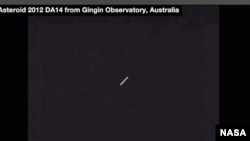An asteroid about 45 meters in diameter flew very near, but safely past, our planet Friday, while a much smaller meteor caused panic and chaos in Chelyabinsk, Russia.
Asteroid 2012 DA14 made its highly anticipated, record-breaking close approach to Earth and then whizzed away, with only those who closely watch the skies or the news aware that that it had come and gone. But that wasn't the case earlier in the day, when an unexpected meteor blazed across the sky and exploded over Chelyabinsk, Russia, inflicting injuries and damage as chunks hit the Earth.
Paul Chodas, a research scientist in the Near Earth Object Program Office at NASA's Jet Propulsion Laboratory in California, emphasized that the two cosmic events are unrelated.
"They are not in the same trajectory or the same orbit," Chodas said during the U.S. space agency's televised coverage of Asteroid 2012 DA14's flyby. "It's simply a coincidence that they happened to hit and come near the Earth the same day."
Russian meteor
NASA says preliminary research indicates the Russian meteor entered the atmosphere at 18 kilometers per second, and released hundreds of kilotons of energy when it became superheated and exploded. Chodas said, at this point, researchers believe the meteor was roughly 15 meters across - about one-third the size of Asteroid 2012 DA14.
"You can see what sort of destruction and shockwave that a smaller asteroid can produce," Chodas said. "It's like Mother Nature is showing us what a small one, a tiny one really, can do, and DA14 is really only a small asteroid on that scale."
Lance Benner, a radar astronomer at NASA's Jet Propulsion Laboratory, is among the scientists who will continue to track 2012 DA14 even as it zooms away after coming within 28,000 kilometers of our planet's surface.
Tracking asteroids
Scientists expect to learn more about its physical characteristics and the way Earth's gravity alters the asteroid's orbit.
"We'll also be measuring its distance and velocity on multiple occasions over the course of the next several days in an attempt to improve our understanding of its orbit and enable us to compute its motion much farther into the future than we could otherwise," said Benner.
The U.S. space agency says, on average, an asteroid the size of 2012 DA14 gets close every 40 years and hits every 1,200 years.
NASA's Chodas says there is "a very tiny possibility" that 2012 DA14 could hit our planet in 2080, but he expects further study of its orbit will rule out that possibility.
Watch the NASA livestream:
Live video from your iPhone using Ustream
Asteroid 2012 DA14 made its highly anticipated, record-breaking close approach to Earth and then whizzed away, with only those who closely watch the skies or the news aware that that it had come and gone. But that wasn't the case earlier in the day, when an unexpected meteor blazed across the sky and exploded over Chelyabinsk, Russia, inflicting injuries and damage as chunks hit the Earth.
Paul Chodas, a research scientist in the Near Earth Object Program Office at NASA's Jet Propulsion Laboratory in California, emphasized that the two cosmic events are unrelated.
"They are not in the same trajectory or the same orbit," Chodas said during the U.S. space agency's televised coverage of Asteroid 2012 DA14's flyby. "It's simply a coincidence that they happened to hit and come near the Earth the same day."
Russian meteor
NASA says preliminary research indicates the Russian meteor entered the atmosphere at 18 kilometers per second, and released hundreds of kilotons of energy when it became superheated and exploded. Chodas said, at this point, researchers believe the meteor was roughly 15 meters across - about one-third the size of Asteroid 2012 DA14.
"You can see what sort of destruction and shockwave that a smaller asteroid can produce," Chodas said. "It's like Mother Nature is showing us what a small one, a tiny one really, can do, and DA14 is really only a small asteroid on that scale."
Lance Benner, a radar astronomer at NASA's Jet Propulsion Laboratory, is among the scientists who will continue to track 2012 DA14 even as it zooms away after coming within 28,000 kilometers of our planet's surface.
Tracking asteroids
Scientists expect to learn more about its physical characteristics and the way Earth's gravity alters the asteroid's orbit.
"We'll also be measuring its distance and velocity on multiple occasions over the course of the next several days in an attempt to improve our understanding of its orbit and enable us to compute its motion much farther into the future than we could otherwise," said Benner.
The U.S. space agency says, on average, an asteroid the size of 2012 DA14 gets close every 40 years and hits every 1,200 years.
NASA's Chodas says there is "a very tiny possibility" that 2012 DA14 could hit our planet in 2080, but he expects further study of its orbit will rule out that possibility.
Watch the NASA livestream:
Live video from your iPhone using Ustream








